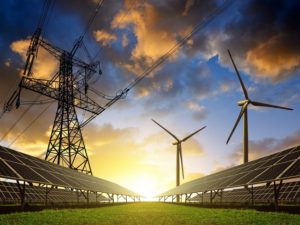Kategori : NATURAL GAS ENERGY NEWS, ELECTRICITY ENERGY NEWS, ENERGY AGENDA NEWS, COAL NEWS, OIL & FUEL SECTOR NEWS - Tarih : 17 January 2019
1) Global coal demand will remain stable
World coal consumption has never been higher than it was in 2013-14, but it seems that that level was a plateau rather than a peak. After declining over 2014-16, global coal demand started to pick up in 2017, and rose again last year. From now until at least 2023, the International Energy Agency has predicted, it  will remain roughly stable, rising or falling only slightly each year. China, which accounts for about half of the world’s coal consumption, has been at the heart of global demand reductions as a result of its drive to improve urban air quality. Concerns about the impact of its policies on coal mining and other industries have led the government to ease off on its strategy of tightening air quality regulations, and China’s coal consumption is expected to decline only slowly over the next few years. Meanwhile, demand is still growing in India and other countries in Asia, including Indonesia, Pakistan, Bangladesh and the Philippines, offsetting declines in the US and western Europe. The longer-term outlook is uncertain. In India, private investment in coal power has ground to a near halt, as many new plants have fallen into deep financial distress in the face of competition from low-cost renewable energy. In China, however, provincial authorities have issued permits that could lead to a “massive surge” in construction of new coal-fired plants. In the short term, however, demand is more predictable, and a small increase or a small decline from 2018 levels seem the most likely possible outcomes. With global oil and gas consumption continuing to grow, flat coal use implies that total world greenhouse gas emissions, which hit a record high last year, are likely to rise again this year.
will remain roughly stable, rising or falling only slightly each year. China, which accounts for about half of the world’s coal consumption, has been at the heart of global demand reductions as a result of its drive to improve urban air quality. Concerns about the impact of its policies on coal mining and other industries have led the government to ease off on its strategy of tightening air quality regulations, and China’s coal consumption is expected to decline only slowly over the next few years. Meanwhile, demand is still growing in India and other countries in Asia, including Indonesia, Pakistan, Bangladesh and the Philippines, offsetting declines in the US and western Europe. The longer-term outlook is uncertain. In India, private investment in coal power has ground to a near halt, as many new plants have fallen into deep financial distress in the face of competition from low-cost renewable energy. In China, however, provincial authorities have issued permits that could lead to a “massive surge” in construction of new coal-fired plants. In the short term, however, demand is more predictable, and a small increase or a small decline from 2018 levels seem the most likely possible outcomes. With global oil and gas consumption continuing to grow, flat coal use implies that total world greenhouse gas emissions, which hit a record high last year, are likely to rise again this year.
2) The US will be an increasingly important gas supplier to the world, in terms of both deliveries and contracts for the future
This is going to be a big year for the first wave of US LNG export projects. Two large new plants, Cameron LNG in Louisiana and Freeport LNG in Texas, are scheduled to come into service, along with a smaller one at Elba Island in Georgia. Meanwhile, Cheniere Energy’s Corpus Christi LNG plant in Texas, which shipped its first commissioning cargo last month, is entering full commercial operation, and aims to have its second production train in service this year. By the end of the year, US LNG export capacity is expected to have more than doubled. The country will be the world’s third-largest exporter of LNG, behind Qatar and Australia, with implications for its relationships with gas consumers around the world, and with other large producers including Russia. An excellent overview of the consequences for gas competition in Europe was published last month by Columbia University’s Center on Global Energy Policy, arguing that while US LNG has cut Russian gas revenues and forced contract renegotiations, Russia is still “in a good position to defend its market share in Europe”. The significance of 2019 for US LNG exporters goes beyond the imminent project start-ups, however. It is also a crucial year for companies hoping to take part in a second wave of US LNG export developments. There are three projects in the US that are expected to get the go-ahead with final investment decisions in the first half half of the year, according to Wood Mackenzie: Qatar Petroleum and ExxonMobil’s Golden Pass LNG, Venture Global LNG’s Calcasieu Pass, and an expansion at Cheniere’s Sabine Pass. Worldwide, with investment approvals also expected for Novatek and Total’s Arctic LNG 2, and at least one project in Mozambique, this could be a record year for commitments to new LNG export capacity, Wood Mackenzie believes. The critical factor in global demand is again China. The drive to shift away from coal has meant a surge in its demand for LNG, and it last year overtook Japan to become the world’s largest gas importer. That means that for other aspiring US LNG exporters also hoping to sign customer contracts and give the green light to their projects this year, a lot depends on the Trump administration’s prosecution of the trade dispute with China. As the winter set in, China imported a couple of cargoes of US LNG, but all the indications have been that Chinese buyers will not sign long-term contracts for as long as the trade war remains unresolved. If a settlement can be reached, however, increased US LNG sales seem likely to be part of it, so a resolution could be good news for those export projects.
3) The costs of renewable electricity and energy storage will continue to fall
The decline in the costs of electricity from renewable sources has not always been smooth. The database kept by Irena, the International Renewable Energy Agency, shows that the global average cost of power from onshore wind levelled off in 2014-16, for example. But over longer periods the decline, driven by economies of scale and incremental improvements in the technology, has been inexorable, and there is no reason to expect it to come to an end this year. The falling cost of renewables has already had a huge impact on global investment in power generation. Even in emerging economies, where economic imperatives typically outweigh concern for environmental impacts, wind and solar power in 2017 overtook fossil fuels for additions of new capacity in power generation. The pressure on coal power in India, discussed above, comes as developers commit to build solar plants selling power for just Rs2.44 (about 4 US cents) a kilowatt hour. With bids of about Rs3/kWh now common, investing in new solar capacity in India is often cheaper than generation from existing coal plants. NTPC, the government-controlled energy group, which has mostly coal-fired plants, charged an average tariff of Rs3.42/kWh in the first half of this fiscal year. The variability of solar power means that the comparisons are not quite apples-to-apples, but the increasing competitive pressure from the declining costs of renewables is real. Meanwhile, the costs of energy storage are also expected to decline, if at a slower pace than earlier in the decade. The price of lithium ion batteries dropped by 80 per cent over 2010-17, according to Bloomberg New Energy Finance, opening up a new range of possible uses such as allowing industrial and commercial users to shave the peaks off their consumption from the grid. Even at these rates of decline, lithium ion batteries are a very long way from being a viable complete solution to the problems created by the variability of wind and solar power. But they are likely to find a growing market in niches providing services to customers and to the grid, and the energy storage market is expected to attract $620bn of investment by 2040, again according to BNEF.
4) Electric car sales will keep rising as a wave of new models hit the market . . .
Electric car sales continued to jump in 2018, blowing past expectations. Total sales of light electric vehicles, including cars, SUVs, and smaller trucks and vans, are expected to have reached about 2.1m, up about 64 per cent from 2018, taking the total number of plug-in vehicles on the roads to about 5.4m. Sales are expected to grow again this year, with Tesla launching its new Model 3 in Europe and China, and a number of new models from manufacturers including Porsche, Mercedes, Audi, Renault, Hyundai and Kia. In China, which is the world’s largest car market and accounts for roughly half of all electric vehicles sold worldwide, new mandates for the production of “new energy vehicles” take effect this year. A system of tradeable credits incentivises companies to develop longer-ranged battery electric vehicles, and will penalise manufacturers that do not achieve targets for production of electric cars as a proportion of their sales. Companies including Honda and Daimler are pushing ahead with plans to build electric cars in China. It is important to keep the rapid growth of electric cars in perspective. Those 5.4m electric vehicles on the road represent only about 0.4 per cent of the total global light vehicle fleet of about 1.3bn. Even if electric car sales continue to rocket — BNEF expects annual sales of 30m by 2030 — they are projected to remain a minority of new vehicle sales until the late 2030s. Although it has been more bullish than some other forecasters — including Opec! — BNEF has underestimated the growth of electric vehicles in the past, and it may be doing so again. China’s electric vehicle strategy, driven by its ambitions to dominate the global industries of the future, strengthen energy security, and ( possibly) improve local air pollution, will be critical. Global sales of cars with internal combustion engines could peak in the mid-2020s, BNEF suggests. Other forecasters think we may have already reached that peak last year. But on any plausible projection there are likely to be hundreds of millions of petrol and diesel fuelled vehicles on the roads for decades to come.
5) . . . But the health of the world economy will have a bigger impact on oil demand this year
If sales of electric vehicles continue to grow rapidly, it will not be long before they start to have a perceptible impact on global oil demand. The IEA has projected that consumption of oil-based fuel for passenger cars could peak in the second half of the 2020s. That is a very different thing from projecting peak demand for oil overall, however, because petrol and diesel for cars account for only about a fifth of global oil consumption. In the IEA’s “new policies scenario”, reflecting announced government commitments and existing technologies, total oil demand is projected to keep rising to 2040, albeit at a slower pace than in the past 25 years.
In the near term, a much more important factor for global oil demand will be the health of the world economy. The last time world oil consumption fell was in 2008-09, when demand was hit first by the surge in prices, with Brent crude briefly rising above $140 a barrel, and then by the sharp recession caused by the financial crisis. The world economy shrank by 2.1 per cent in 2009, making it the worst downturn since the Great Depression, and oil consumption dropped by 1.7 per cent.
A repeat of that slump seems highly unlikely, but in October the IEA and Opec both cut their forecasts for oil demand growth in 2019, because of concerns about the impact of higher prices and a deteriorating economic outlook. Since then, prices have fallen, which will help support consumption, but expectations for the world economy have become more gloomy.





